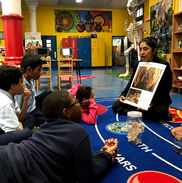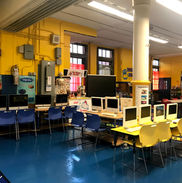THE
EXPLORATION
CENTER
Created by Ms. Jacqueline Garcia
The Bilingual School’s Exploration Center was created by the bilingual coordinator of the school Ms. Jacqueline Garcia. The center's focus consists of academic achievement and language development through the content areas, as well as strengthens our student's social development through the use of instructional methods in reading, writing, speaking, listening, and cultural awareness.
The Exploration Center has a variety of stations where students can manipulate materials with or without the teacher’s supervision to promote advanced innovative learning. It has a variety of habitats and specimens where students can make observations, describe what they see, make inferences to create a hypothesis, while they develop and learn new ideas and concepts through science exploration. We believe when students are able to touch specimens and make direct observations (such as comparing the jaws of an herbivore to a carnivore) they internalize the concepts through concrete experiences that will last a lifetime.
Animal specimens are incorporated into our classroom lessons of animal studies, supported by the appropriate grade level literature. The resources used in our Exploration Center support and enrich our curriculum and student learning by using resources that promote hands-on experiential learning.
The benefits of our Exploration Center:
-
The Exploration Center responds to children’s needs to learn about the world around them.
-
Children’s everyday experience is the foundation for science and exploration
-
Open-ended science activities at the center can involve children at a wide range of developmental levels.
-
Hands-on science activities let teachers observe and respond to children’s individual strengths and needs during the process of learning through discovery
-
Science strongly supports language and literacy through books available at the center.
-
Nonfiction books become a powerful foundation for conversations with adults and peers.
-
Vocabulary growth is supported by children’s prior knowledge and experience of the everyday world. This is coupled with observation and hands-on activities done at the center and can be a way to integrate content-area instruction with language development.
-
Receptive language (listening comprehension) is fostered as children listen to the teacher read aloud and talk about the science activity.
-
The expressive language during an activity is fostered as the teacher leads children through a cycle of scientific reasoning and especially as the teacher supports the children in developing a report of their findings.
-
-
Science and Hands-on activities help children with limited language skills to participate in the classroom and learn English. It connects easily to other content areas such as social studies, creative writing, literacy and math.

_edited.png)




















